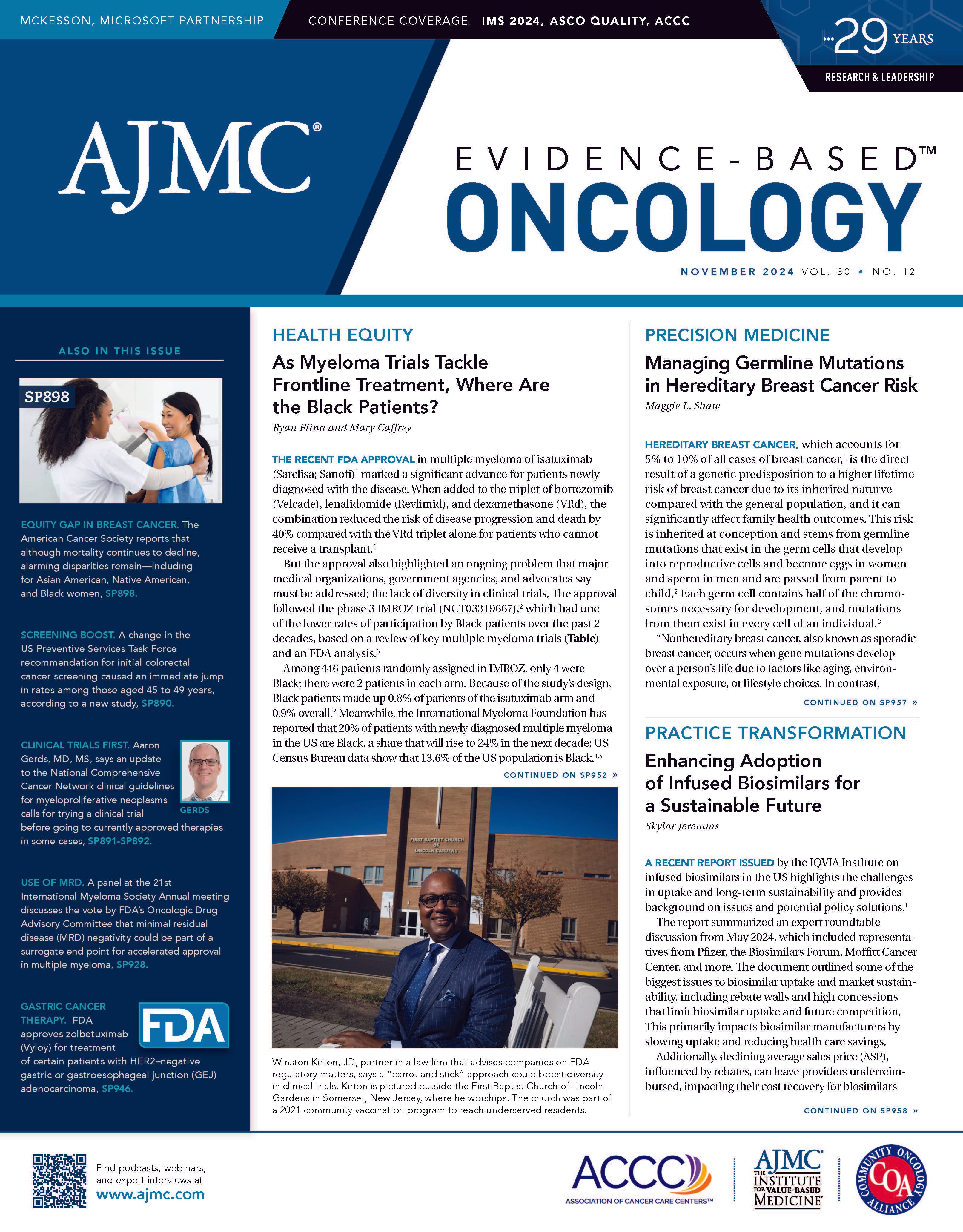- Center on Health Equity & Access
- Clinical
- Health Care Cost
- Health Care Delivery
- Insurance
- Policy
- Technology
- Value-Based Care
SPOTLIGHT: What the Approval of Isatuximab Plus VRd Means to Multiple Myeloma Care
The recent FDA approval of isatuximab-irfc (Sarclisa; Sanofi-Aventis US LLC) in combination with the triplet therapy bortezomib (Velcade), lenalidomide (Revlimid), and dexamethasone (VRd) adds another option for patients with transplant-ineligible multiple myeloma.1
Surbhi Sidana, MD | Image: Stanford

In an earlier interview with The American Journal of Managed Care, a sister publication of Evidence-Based Oncology (EBO), Surbhi Sidana, MD, vice chair of the American Society of Hematology’s Committee on Communications and associate professor of medicine and director of the Myeloma Disease Focused Group at Stanford University in California, explained the importance of this approval and how it addresses treatment gaps for patients with transplant-ineligible multiple myeloma.2
Here, she delves deeper into the treatment’s progression-free survival (PFS) data, how clinicians can incorporate isatuximab plus VRd into treatment for older patients, and how the standard of care for multiple myeloma has changed over the past few years.
This transcript has been lightly edited for clarity.
EBO: Can you elaborate on the clinical significance of the PFS data from the phase 3 IMROZ trial3 (NCT03319667)?
Sidana: I think that is the critical time point. Progression-free survival is time until progression or death from any cause, and that is a very valid surrogate end point that has been accepted in the field. And what we saw was the progression-free survival was significantly higher with a quadruplet, with a hazard ratio of 0.6 compared [with] the triplet.3 This tells us that, yes, addition of an anti-CD38 antibody to the VRd backbone significantly improves progression-free survival.
Now, at current follow-up, we did not see any difference in overall survival.3 The data [are] still immature, but you could see the curve starting to separate, so hopefully in the future we will see that as well. Again, [this is] telling me that an anti-CD38 antibody is important to improve outcomes of patients.
Is bortezomib needed? Bortezomib was used twice weekly in these patients. Twice weekly in transplant-ineligible patients is a significant amount of bortezomib. We saw high rates of peripheral neuropathy. Of course, when we use this in the real world, even if we are using a triplet, we never use twice-a-week bortezomib. We always use once-a-week bortezomib, and we’ll never use it in transplant-ineligible patients. So that is where the trial design does not translate into the real world.
...There’s another trial called the BENEFIT trial [NCT04751877],4 which is truly looking at regimens that can be used in frail and [older] patients. That [trial randomly assigned] patients to isa [isatuximab]/VRd or isa/Rd, so everybody gets an anti-CD38, but you add bortezomib on top of it. There, bortezomib was used once a week subcutaneously for 18 months and then stopped. So I think that trial will tell us what the addition of once-a-week bortezomib does to these patients. But taking all of this together, yes, add an anti-CD38 [for] your transplant-ineligible patients—and [for] your transplant-eligible patients, looking at other data.
EBO: VRd is the current standard of care for transplant-ineligible multiple myeloma but has been quoted as not often doing so well. What does the approval of isatuximab plus VRd mean for patients?
Sidana: Just to provide some context, in the original trial, the SWOG S0777 trial [NCT00644228]that Dr [Thierry Facon, MD, of Lille University Hospital] was referring to, the median PFS with VRd was 43 months.5 Here in the IMROZ trial, it’s about 54 months—almost a year better.3 I think this is where the challenge of comparing 2 clinical trials that are done more than a decade apart comes in.
A lot of things have changed. The way we define active myeloma that needs treatment has changed. That was in the era of just defining myeloma with CRAB criteria.5 Now we have additional criteria, so some people [whom] we would not have treated as [having] active myeloma then, we treat them now [under] the SLiM CRAB criteria.6 Our supportive care also is better. So I think we have to be very cautious of comparing trials done...10 to 15 years apart.
...So I think that is the difference why the VRd arm almost did 1 year better in [the IMROZ] clinical trial than the other clinical trial. But, as I said, most of us are not using VRd as our standard of care anymore for transplant-ineligible [myeloma]. We are using dara [daratumumab (Darzalex)]/Rd.6 This doesn’t answer that question exactly, but all of this emerging evidence taken together points us in the right direction.
EBO: How should clinicians balance the benefits of isatuximab plus VRd with the potential risks of adverse events, particularly for older or more vulnerable patients with multiple myeloma?
Sidana: Seventy percent of patients in this clinical trial (IMROZ) were [older than] the age of 70. We don’t exactly know the frailty of that population yet—I’m sure it’ll come out in subsequent publications—but this was an older patient population. And just like with all of the other clinical trials of an anti-CD38 antibody, be it isatuximab or daratumumab, 2 things stood out in the safety profile. One is more grade 3 and 4 neutropenia, which is an absolute neutrophil count of less than 1000, and more infections that were grade 3 and 4. Those 2 things we have to keep in mind. That is always going to be there with the addition of an anti-CD38 antibody.
References
1. FDA approves isatuximab-irfc with bortezomib, lenalidomide, and dexamethasone for newly diagnosed multiple myeloma. FDA. Updated September 20, 2024. Accessed September 20, 2024. https://fda.gov/drugs/resources-information-approved-drugs/fda-approves-isatuximab-irfc-bortezomib-lenalidomide-and-dexamethasone-newly-diagnosed-multiple
2. Shaw ML. Isatuximab approval highlights role of anti-CD38 antibody in myeloma care. AJMC. October 2, 2024. Accessed October 16, 2024. https://www.ajmc.com/view/isatuximab-approval-highlights-role-of-anti-cd38-antibody-in-myeloma-care
3. Facon T, Dimopoulos MA, Leleu XP, et al; IMROZ Study Group. Isatuximab, bortezomib, lenalidomide, and dexamethasone for multiple myeloma. N Engl J Med. Published online June 3, 2024. doi:10.1056/NEJMoa2400712
4. Leleu X, Hulin C, Lambert J, et al. Isatuximab, lenalidomide, dexamethasone and bortezomib in transplant-ineligible multiple myeloma: the randomized phase 3 BENEFIT trial. Nat Med. 2024;30(8):2235-2241. doi:10.1038/s41591-024-03050-2
5. Durie BGM, Hoering A, Abidi MH, et al. Bortezomib with lenalidomide and dexamethasone versus lenalidomide and dexamethasone alone in patients with newly diagnosed myeloma without intent for immediate autologous stem-cell transplant (SWOG S0777): a randomised, open-label, phase 3 trial. Lancet. 2017;389(10068):519-527. doi:10.1016/S0140-6736(16)31594-X
6. Facon T, Kumar S, Plesner T, et al; MAIA Trial Investigators. Daratumumab plus lenalidomide and dexamethasone for untreated myeloma. N Engl J Med. 2019;380(22):2104-2115. doi:10.1056/NEJMoa1817249

